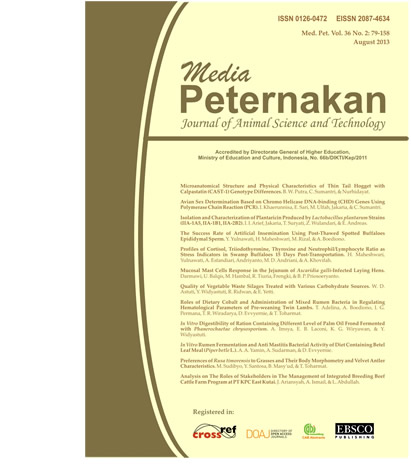Quality of Vegetable Waste Silages Treated with Various Carbohydrate Sources
Abstract
The aim of this research was to evaluate the quality of vegetable waste silages, using rice bran, onggok (cassava flour waste) and pollard as carbohydrate sources. Vegetable waste was collected from local traditional market, consisted of corn husk, chinese cabbage and cabbage. Research was held in randomized block design consisted of six treatments with 3 replications. Treatments were (T1) vegetable waste + rice bran, (T2) vegetable waste + rice bran + rice straw, (T3) vegetable waste + onggok, (T4) vegetable waste + onggok + rice straw, (T5) vegetable waste + pollard, (T6) vegetable waste + pollard + rice straw. Lactobacillus plantarum 1A-2 was used as innoculant. The quality of silages was evaluated by measuring pH, temperature, population of lactic acid bacteria and lactic acid production. Nutrient characteristic was determined by proximate and fiber analysis. Results showed that pH of silages were not affected by treatments, but silage treated with rice bran, with or without rice straw addition, had higher temperature compared with others (29 oC or 28.3 oC). The highest population of lactic acid bacteria (1.65 x 109 cfu/g) was found in silage using rice straw and onggok (T4), but the highest lactic acid production (0.41%) was measured in silage using rice straw and rice bran (T2). In general, the use of rice bran as carbohydrate sources gave the highest lactic acid production followed by pollard and onggok. Different carbohydrate source gave different nutrients characteristic. Although the result was not significantly different, silage with highest protein content was measured in silage with pollard as carbohydrate source, followed with rice bran and onggok. The result showed that all carbohydrate sources used in this experiment can be used as silage ingredient resulting in good vegetable waste silage.



